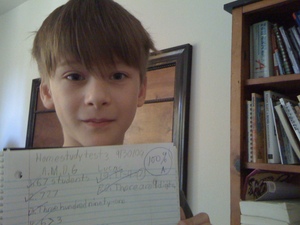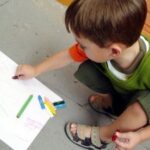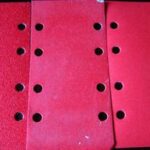Do you ever dream of the time when your math-phobic child will one day come to terms with his fear and gain confidence in his mathematical abilities? What is the critical factor that differentiates a student with superb math abilities among his peers? The answer to that is CONFIDENCE. You cannot have confidence if you do not have an excellent math training under your belt. What mathematical training do you need before college to have that confidence? The answer is the Robinson Curriculum Math.
The Robinson Curriculum is a self-teaching home school curriculum which won the 2008 Practical Homeschooling Reader Awards, specifically first place, in the following categories: Middle School curriculum, High School curriculum, Grammar Language Arts, Vocabulary, Literature, Spelling, and History. The Robinson Curriculum uses the basic philosophy of autodidact learning or self-teaching. The Robinson Curriculum removed the clutter of numerous subjects in the home school environment and focuses mainly on the 3 R’s namely Reading, Math (aRithmetic), and wRiting. The Robinson Curriculum simplifies the home school schedule, the courses studied and the output so the parents can manage efficiently their home school goals without feeling overly overwhelmed and stressed out.
The math aspect of the Robinson Curriculum is also known as Saxon Math. It is an easily recognizable math program in the home school market that spans from Math K to Saxon Math Physics. However, there is a difference in how Saxon Math is implemented in the Robinson Curriculum.
Dr. Art Robinson, founder of the Robinson Curriculum, recommends starting the Robinson Curriculum Math using Saxon Math 5/4 for the child in 3rd grade or a child about 8 years old. However, the child must be able to master his math facts to 12 in order to have success in this way.
For children under 8 years old and 3rd Grade
Prior to Saxon 5/4, the child is recommended to practice the math facts cards for two hours each day. The child memorizes the math facts daily until the child achieves mastery.The child can set aside, in a pile, the math fact cards missed. The child can review this first in the next math session. When the child gains accuracy for all math facts in all operations (addition, subtraction, multiplication, division) up until the factor 12, the child is ready for Saxon 5/4.
Robinson Curriculum Math
The Saxon Math textbooks used in the Robinson Curriculum include the following:
Saxon 5/4
Saxon 6/5
Saxon 7/6
Saxon 8/7
Saxon Algebra 1/2
Saxon Algebra
Saxon Algebra 2
Saxon Advanced Math (Precalculus)
Saxon Calculus
The above list is not the whole range of what Saxon Math offers in its website. The Robinson Curriculum omitted Saxon Math K, 1, 2, 3 and Saxon Physics. The Robinson Curriculum has another Physics book recommendation in its curriculum. It is also important to note that the Robinson Curriculum Math recommends undertaking Saxon 8/7 and Saxon Algebra 1/2 and not skipping these two important books as suggested by other home school providers. Dr. Robinson finds merits in finishing these two books to gain enough preparation for the next level of mathematics.
If the Robinson Curriculum Math is followed diligently with its all year round schedule and 6-day week schedule with no summer and long holiday breaks, the child can finish Saxon Math Calculus at 14 years old. At this point, the child is prepared adequately for college level science courses such as Physics, Chemistry and Biology.
The Robinson Curriculum Math Discipline
Though Saxon Math is utilized by many home school providers as its math component, the failure of many is in how it is implemented. The Robinson Curriculum math ensures success with Saxon Math through the following guidelines.
1. Do not do odds or evens only
For those undertaking Saxon Math for the first time, the right placement of the child in the series is often overlooked. The parent is pressured to put the child in his or her public school math grade level equivalent. Some parents try to catch up the child by allowing the child just to do odds or even numbers in the problem set. Furthermore, the parents give in to the child’s grievances by easing up the child’s work and allowing them to do the bare minimum. These attempts will come around against the child at a certain point in his math studies.
2. Do math as the first subject of the day
Math is analogous to physical exercises. It is a discipline that will help the child’s brains if it is done in the first part of the day. Math conditions the brain like how physical exercises condition our body.
3. Accuracy is possible
Error graphing is recommended by Dr. Robinson. This means charting the errors of the child instead of the correct answers. Dr. Robinson allows for a 5% error rate. This means a maximum error of two (2) for each problem set.
If the child commits more than two errors a day, it is possible that a child is creating a habit of carelessness or probably the lesson for the day is not easy for him. Sometimes, a child may even feel that 100% accuracy is impossible. If this happens, the parent must assess the child’s work and find out if the child needs to slow down to half of the lesson per day.
Robinson Curriculum users have found a new strategy for accuracy. They let their child do the first five exercises in a lesson and encourage the child to re-check this first set. The child proceeds to the next five exercises and then re-checks until he finishes the entire 25 or 30 exercises in the lesson, as the case may be.
4. Distractions can be prevented by the parent’s presence
Though this method is self-teaching, do not be tempted to leave the child alone to work on his Saxon Math problems. A child can be easily tempted to find more interesting things to do with his time without you. With a parent’s presence, the child is reminded of your expectations.
5. Refrain from assisting your child
The lessons in Saxon Math is presented carefully in simple words. There is almost no assistance required from the parents. However, typographical errors are still found in some Saxon Math editions. Sometimes, a child will seek assistance from their parents. You should hear the child out and carefully guide them to go back to the lesson numbers to which the exercises pertain.
Encourage your child to find out the answers to his questions by himself. Everything he needs to know can be found in his textbook. Praise him generously when he finds the discrepancies. If he becomes stressed out about it, provide him with techniques to calm him down and let him try again to work out the problem. You can also let him read aloud the problem sentence by sentence and draw the problems so he can visualize it better.
Conclusion:
The Robinson Curriculum Math is a more disciplined implementation of the Saxon Math series. If done properly, the Robinson Curriculum Math will do wonders in the confidence level of your child. Eventually you will find a child conquering an insecurity that will change his attitude towards his education. Math, being the language of science, will raise your child to another level in his studies where he will find obstacles as surmountable. Math will eventually be treated like a game that he can win instead of a setback to be depressed about.
Sources:
2008 Practical Homeschooling Awards, Home-school.org
Robinsoncurriculum.com






